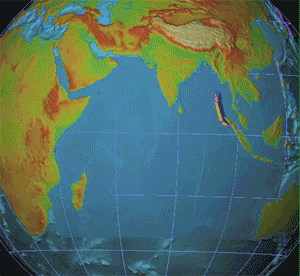Giant forces that had been building up deep in the Earth for hundreds of years were released suddenly on December 26, shaking the ground violently and unleashing a series of killer waves that sped across the Indian Ocean at the speed of a jet airliner.
By the end of the day more than 150,000 people were dead or missing and millions more were homeless in 11 countries, making it perhaps the most destructive tsunami in history.
The epicenter of the 9.0 magnitude quake was under the Indian Ocean near the west coast of the Indonesian island of Sumatra, according to the USGS, which monitors earthquakes worldwide. The violent movement of sections of the Earth's crust, known as tectonic plates, displaced an enormous amount of water, sending powerful shock waves in every direction.
The Indian Ocean tsunami traveled as much as 3,000 miles (nearly 5,000 kilometers) to Africa, arriving with sufficient force to kill people and destroy property.
A tsunami may be less than a foot (30 centimeters) in height on the surface of the open ocean, which is why they are not noticed by sailors. But the powerful pulse of energy travels rapidly through the ocean at hundreds of miles per hour. Once a tsunami reaches shallow water near the coast it is slowed down. The top of the wave moves faster than the bottom, causing the sea to rise dramatically.
The Indian Ocean tsunami caused waves as high as 50 feet (15 meters) in some places, according to news reports. But in many other places witnesses described a rapid surging of the ocean, more like an extremely powerful river or a flood than the advance and retreat of giant waves.

People who knew geography knew what the receding ocean meant. Survivors who knew it meant trouble reported how they ran for high ground, rounded up family and friends, and tried to warn people who were drawn to the water's edge. Experts say that a receding ocean may give people as much as five minutes' warning to escape to high ground. That may have been enough time for many of the people who were killed by the 2004 tsunami to save themselves, if only they knew what to do.
The damage it did :
The Indian Ocean tsunami destroyed thousands of miles of coastline and even submerged entire islands permanently. The island country Maldives rises only a few feet above sea level, but it is largely protected by outlying coral reefs. Even so, the tsunami swept across the reefs and was reported to have washed over some islands entirely. The capital and many tourist resorts in the Maldives were flooded. Astonishingly, relatively few people were killed. The country was likely protected from the full force of the tsunami by its reefs.
then...
As the day of horror drew to a close the ocean calmed. But where at the start of the day people were going about their normal lives or relaxing at exotic beach resorts now millions of people were struggling with the reality of tens of thousands of dead or missing relatives, destroyed homes, and shattered lives. The thousands of corpses, many hanging in trees or washed up on beaches, immediately started to rot in the tropical heat. With no food or clean water and open wounds, the risk of famine and epidemic diseases was high. Health authorities feared that the death toll might double to 300,000.
Across the world the magnitude of the disaster and the scale of the suffering prompted a new wave—one of sympathy, support, and assistance for the people affected by the tsunami.
Deep beneath the ocean, at the source of the great earthquake and tsunami, the Earth's tectonic plates continued their relentless pressing against one another. Pressure was already building for the day when pent-up energy will once again be released violently—but hopefully not for hundreds of years.

National Geographic News
Updated January 7, 2005









COMMENTS
-
hannahrose
13:21 May 28 2012
VERY INTERESTING AND VERY TOUCHING .I HOPE THAT THERE WILL NEVER BE ANOTHER TSUNAMI AS LONG AS I LIVE. THIS IS A REMINDER TO LIVE EVERYDAY WELL AS IF IT WAS YOUR LAST AND TO MAKE THE MOST OUT OF EVERY DAY AS YOU NEVER KNOW WHAT DAY YOU OR THOSE YOU LOVE WILL BE CALLED HOME TO SPIRIT.
vivi
19:55 May 28 2012
Its a good move,a page on tsunami.perhaps the greatest disaster that the mankind ever faced.And these will remind humans dat we are nothing before the forces of nature,no matter whatever technology we develop,how rich we are and what ever stuff we have........so know u better before doing anything
queenofchaos
07:40 May 29 2012
Very nice job here my Dear.
MoriendoRenascor
09:15 May 29 2012
Wow...excellent & thoughtful work!
I remember turning on CNN that day & not believing what I was seeing. I grew up in southern California & have experienced many earthquakes...and we always lived in fear of "The Big One."
Hopefully, another one of that magnitude won't happen in the near future, but as they say..."Nature will always win in the end."
Nefas
10:45 May 29 2012
Thanks for sharing I do remember reading about this online minutes after it happened.
OzmanitisTheMighty
13:04 May 29 2012
My heart was sadden and horrified as I watched the videos of the terrible wave claim and devastate so many. Such a tragic and sad day, as well as a reminder that although we live on this planet. Nature rules it.
Excellent page
BlackLullaby
07:41 May 30 2012
thanx for the comments ♥ ♥ ♥ ♥
skyrah
08:37 May 30 2012
Thanks for sharing thoughtful friend
QueenZombie
14:02 May 30 2012
Thanks for sharing this.
veauclin
20:35 May 30 2012
really informative thank you
Rammknat
08:34 May 31 2012
Very well thought out and detailed report, Thank you
BlackLullaby
10:54 May 31 2012
thanx for the comments ♥ ♥ ♥ ♥
Seshat
00:14 Jun 01 2012
A beautiful page!
WickedHell
12:53 Jun 08 2012
Wonderful job on a very tragic subject.
mizore
07:28 Jun 11 2012
This is a very good news .. tragict but very helpfull for all the news
cadrewolf
04:19 Jun 12 2012
most excellent
marybloodymary
10:49 Jun 12 2012
aptly put.
BlackLullaby
08:05 Jun 13 2012
thanx =)
SireThomas
19:10 Oct 11 2013
Very well thought and put together all around great work